Comb management is an important aspect of beekeeping, but comb management has not always been a management strategy of beekeepers. Rather, comb management is a fairly new concept. Beekeepers started managing comb with the invention of the Langstroth hive in the 1850’s. Today, comb management is a common practice for beekeepers, and an aspect of beekeeping beekeepers must be cognizant of. Because of the importance of comb management, I am writing 4-part blog-series on the subject. The blog-series is split into 4 parts:
- History of comb management
- Management strategies of foundation
- Cell size: why so much variation between producers?
- Benefits of replacing old comb
I hope you enjoy this series and find information to discuss!
Historically, comb management was virtually non-existent because pre-1850’s beekeeping because colonies did not have removable frames. Beekeepers kept colonies in makeshift enclosures, and oftentimes these colonies were made of local materials found in specific regions. These beekeepers built hives with 3 basic premises: 1) the colonies must be protected from extreme weather, 2) a flight entrance must be provided that is small enough for the colony to defend predators, and 3) the hive must contain an opening to remove honey (Graham,1992). Below are pictures of different colony enclosures:
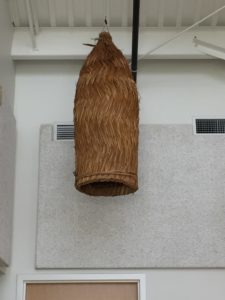
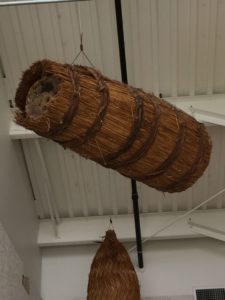



These hives protected bees well; however, these hives had one common problem: the comb needed to be cut and destroyed to harvest honey. Post-harvest, bees had to rebuild comb, an energy expensive task. Moreover, these hives offered other challenges, such as colonies were difficult to inspect and bees were easily angered. Lorenzo Lorraine Langstroth identified this problem in his 1851 diary entry:
“Pondering, as I had so often done before, how I could get rid of the disagreeable necessity of cutting the attachments of the combs from the walls of the hives, and rejecting, for obvious reasons the plan of uprights, close fitting(or nearly so) to these walls, the almost self-evident idea of using the same bee space as in the shallow combs came into my mind, and in a moment the suspended movable frames, kept at a suitable distance from each other and the case containing them, came into being. Seeing by intuition, as it were, the end from the beginning, I could scarcely refrain from shouting out my “Eureka!” in the open streets.”
L.L. Langstroth developed a hive with removable frames, which is called the Langstroth hive today. Frames were easily moved and designed so the frames were spaced properly to overcome bees tendency to propolize in smaller spaces. With the Langstroth colony, beekeepers could now easily inspect colonies for diseases, bees would be disturbed less often, colonies could be easily split, frames with honey could be easily removed without disturbing or destroying brood, and it became easier to compartmentalized queens using queen excluders (Graham,1992). The Langstroth hive changed beekeeping forever and influenced beekeeping today. But L.L. Langstroth’s invention did offer a new challenge: comb management.
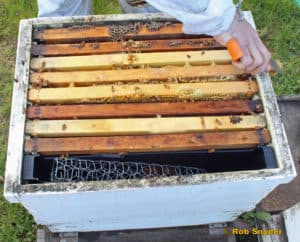
L.L. Langstroths’s idea of a removable frame was not a novel idea. A blind beekeeper by the name of Francois Huber developed a leaf hive, the first colony with removable frames (Huber, 1821). The leaf hive consists of 12 vertical frames or boxes that are parallel to each other. It is evident that Huber influenced L.L. Langstroth’s idea. In “Langstroth on the hive and the honey bee” (1860), L.L. Langstroth stated:
“The use of the huber hive had satisfied me, that with proper precautions the comb might be removed without enraging the bees, and that these insects were capable of being tamed to a surprising degree. Without knowledge of these facts, I should have regarded a hive permitting the removal of the combs, as quite too dangerous for practical use.”
From this, L.L. Langstroth developed the hive equipment we see today.
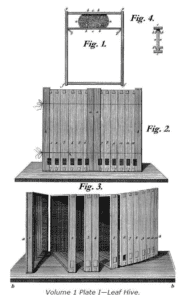
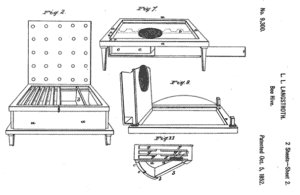
Improvements have been made to the original Langstroth hive, but the overall idea remains the same. This invention was a major turning point for beekeeping because the Langstroth hives provided the impetus for contemporary beekeeping. Bees became easier to manage, and interest in beekeeping rose. But as beekeeping changed, so did management practices. Today, beekeepers manage comb differently than pre-1850’s beekeepers, and because of this, comb management has become an important management practice.
Next time…
Artificial foundation was developed shortly after the invention of the removable frames. The first matrix frame was invented by Johannes Mehring in Germany (Graham,1992). But as more people began producing artificial foundation for Langstroth hives, beekeepers began experimenting with different sized cells. Stay tuned for Part 2 to find out what happened…
Citations
Langstroth, L. L. (1859). Langstroth on the hive & honey bee. American bee journal.
Graham, J. M. (Ed.). (1992). The hive and the honey bee (No. 638.12 G7 1992). Hamilton, IL: Dadant & Sons.
Huber, F. (1821). New observations on the natural history of bees. W. & C. Tait, and Longman, Hurst, Rees, Orme, and Brown, London.